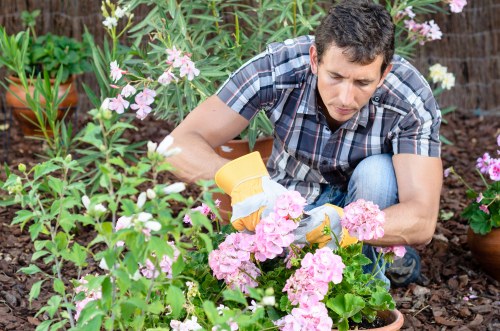Expert Hedge Trimming in Soho: Enhancing Your Green Spaces
Introduction to Hedge Trimming in Soho

Maintaining well-trimmed hedges is essential for both the aesthetic appeal and the health of your greenery. In the vibrant and bustling area of Soho, where space is often at a premium, hedge trimming serves as a crucial element in landscaping, providing structure and beauty to residential and commercial properties alike.
Proper hedge trimming not only enhances the visual appeal of your property but also promotes the health and growth of your plants. In Soho, where greenery can provide a necessary respite from the urban environment, maintaining your hedges is more important than ever.
Whether you are a homeowner looking to improve your garden or a business owner aiming to create an inviting exterior, understanding the nuances of hedge trimming in Soho can help you achieve the desired results.
Benefits of Regular Hedge Trimming

Regular hedge trimming offers numerous benefits that extend beyond mere aesthetics. Healthy hedges can act as natural barriers, providing privacy, reducing noise pollution, and even contributing to better air quality in densely populated areas like Soho.
Trimming your hedges stimulates new growth, ensuring that your plants remain dense and vibrant throughout the year. This not only keeps your garden looking lush but also helps in maintaining the structural integrity of the hedges.
Moreover, well-maintained hedges can increase the value of your property. Potential buyers or clients are often impressed by neat and tidy landscapes, making hedge trimming a worthwhile investment.
Types of Hedges Common in Soho

Soho boasts a variety of hedge types, each with its own unique characteristics and trimming requirements. Some of the most common hedges you’ll encounter include:
- Boxwood: Known for its dense foliage and versatility, boxwood is a popular choice for formal gardens.
- Lime: Lime hedges are appreciated for their rapid growth and ability to create natural barriers.
- Privet: Privet hedges are favored for their lush greenery and ease of maintenance.
- Laurel: With large leaves and robust growth, laurel hedges are ideal for creating privacy screens.
Understanding the specific needs of each hedge type is crucial for effective trimming and maintenance.
When to Trim Your Hedges

Timing is key when it comes to hedge trimming. In Soho, the best times to trim your hedges are typically in late spring and early autumn. These periods coincide with the natural growth cycles of most hedge plants, allowing for optimal shaping and health.
Avoid trimming during the peak of summer or the depths of winter, as extreme temperatures can stress the plants and hinder their growth. By scheduling your hedge trimming sessions during the appropriate seasons, you ensure that your hedges remain healthy and vibrant year-round.
Additionally, regular trimming intervals, such as every 6-8 weeks during the growing season, help maintain the desired shape and prevent overgrowth.
Tools and Equipment for Hedge Trimming

Having the right tools is essential for effective hedge trimming. Whether you choose to undertake the task yourself or hire a professional service in Soho, the following equipment can make the process easier and more efficient:
- Pruning Shears: Ideal for small branches and precise cuts.
- Hedge Trimmers: Battery-powered or electric trimmers are perfect for larger hedges, providing a clean and even cut.
- Loppers: Useful for thicker branches that are beyond the reach of standard shears.
- Gloves and Safety Gear: Protecting your hands and eyes is crucial during the trimming process.
Investing in quality tools can significantly improve the outcome of your hedge trimming efforts.
DIY vs. Professional Hedge Trimming in Soho
Deciding whether to trim your hedges yourself or hire a professional service in Soho depends on various factors, including the size of your hedges, your budget, and your level of expertise.
DIY Hedge Trimming
Trimming hedges yourself can be a rewarding experience, offering complete control over the shaping and maintenance process. It’s also a cost-effective option for those who enjoy gardening and have the necessary tools.
Professional Hedge Trimming
Hiring a professional ensures that your hedges are trimmed with expertise and efficiency. Professionals can handle complex shapes, large hedges, and provide comprehensive maintenance services that might be challenging for DIY enthusiasts.
Factors to Consider
- Time: Professional services can save you valuable time, especially for large or numerous hedges.
- Skill Level: Experienced trimmers can achieve precise and aesthetically pleasing results.
- Safety: Professionals are trained to handle equipment safely, reducing the risk of injury.
Choosing a Hedge Trimming Service in Soho
When selecting a hedge trimming service in Soho, it’s important to consider several key factors to ensure you receive quality service. Here are some tips to guide your decision:
Experience and Expertise
Choose a service with a proven track record and expertise in handling various hedge types. Experienced professionals are more likely to deliver satisfactory results.
Customer Reviews and Testimonials
Reading reviews and testimonials can provide insights into the reliability and quality of the service provider. Positive feedback is a good indicator of trustworthy service.
Pricing and Transparency
Ensure that the service offers clear and competitive pricing. Avoid providers who are vague about costs or charge hidden fees.
Questions to Ask
- What is your experience with hedge trimming in Soho?
- Can you provide references or examples of previous work?
- What is included in your service package?
- Do you offer any guarantees or follow-up services?
Steps for Effective Hedge Trimming
Achieving well-maintained hedges involves a systematic approach. Follow these steps to ensure effective trimming:
1. Assess the Hedge
Examine the overall health and structure of your hedge. Identify any diseased or damaged branches that need removal.
2. Plan the Shape
Decide on the desired shape, whether it’s formal and geometric or more natural and flowing. Having a clear vision helps guide the trimming process.
3. Start Trimming
Begin by trimming the sides, followed by the top. Use sharp tools to make clean cuts, ensuring the health of the plants.
4. Maintain Consistency
Trim regularly to maintain the shape and prevent overgrowth. Consistency is key to keeping your hedges looking their best.
Additional Tips
- Trim in dry weather to avoid spreading diseases.
- Use proper techniques to avoid damaging the plants.
- Dispose of trimmings responsibly to maintain a clean garden.
Maintaining Your Hedges After Trimming
Post-trimming care is essential for the longevity and health of your hedges. Implement the following maintenance practices:
Watering
Ensure your hedges receive adequate water, especially during dry spells. Proper hydration supports healthy growth and recovery after trimming.
Fertilizing
Apply appropriate fertilizers to provide essential nutrients. This promotes robust growth and strengthens the plants against pests and diseases.
Monitoring for Pests and Diseases
Regularly inspect your hedges for signs of pests or diseases. Early detection and treatment can prevent significant damage and maintain plant health.
Seasonal Care
- Spring: Begin regular trimming as growth resumes.
- Summer: Maintain shape and health with consistent watering.
- Autumn: Prepare for winter by reducing trimming frequency.
- Winter: Minimal trimming to protect against frost damage.
Common Mistakes to Avoid in Hedge Trimming
Avoiding common mistakes can significantly improve the outcome of your hedge trimming efforts. Here are some pitfalls to watch out for:
- Over-Trimming: Removing too much foliage can stress the plants and inhibit healthy growth.
- Improper Tool Use: Using dull or inappropriate tools can damage the hedge and result in uneven cuts.
- Ignoring Plant Health: Trimming when the hedge is unhealthy can exacerbate problems and hinder recovery.
- Lack of Consistency: Inconsistent trimming schedules can lead to unruly and unattractive hedges.
By being mindful of these common errors, you can ensure that your hedges remain healthy and visually appealing.
Environmental Impact of Proper Hedge Trimming
Proper hedge trimming has positive environmental implications, especially in urban settings like Soho. Well-maintained hedges contribute to the following:
Air Quality Improvement
Healthy hedges absorb carbon dioxide and release oxygen, enhancing the air quality around your property. This is particularly beneficial in densely populated areas with higher pollution levels.
Biodiversity Support
Hedges provide habitats for various species of birds, insects, and small animals. Maintaining your hedges supports local biodiversity and contributes to a balanced ecosystem.
Temperature Regulation
Hedges can act as natural insulators, reducing heat buildup around buildings and mitigating the urban heat island effect common in cities like Soho.
Sustainable Trimming Practices
- Use eco-friendly tools to minimize environmental impact.
- Dispose of trimmings through composting or green waste recycling.
- Opt for native hedge species that are well-suited to the local climate and soil conditions.
Choosing the Right Hedge Trimming Techniques
Different hedge types and desired shapes require specific trimming techniques. Here are some commonly used methods:
Heading Back
This technique involves removing the top portion of the hedge to encourage denser growth. It's suitable for creating formal shapes and maintaining overall structure.
Shearing
Shearing gives hedges a uniform and manicured appearance. It’s ideal for boxwood and other similar hedge types.
Thinning
Thinning involves selectively removing branches to improve air circulation and light penetration. This method enhances the health and appearance of the hedge.
Blending Techniques
- Combine heading back and shearing for a balanced and tidy look.
- Use thinning selectively to address dense areas without compromising the hedge’s shape.
- Adapt your techniques based on the specific needs of your hedge type.
Cost Factors in Hedge Trimming Services
The cost of hedge trimming services in Soho can vary based on several factors. Understanding these can help you budget appropriately:
Hedge Size and Density
Larger and denser hedges require more time and effort to trim, resulting in higher costs. Professional services may charge based on the length and complexity of the job.
Accessibility
The ease of accessing your hedges plays a role in pricing. Hedges situated in hard-to-reach areas or with challenging terrain may incur additional charges.
Frequency of Trimming
Regular maintenance contracts can offer cost savings compared to one-time trimming services. Establishing a schedule with your provider ensures consistent care.
Additional Services
- Pruning and shaping beyond basic trimming.
- Removal of dead or diseased branches.
- Application of fertilizers or pest treatments.
Seasonal Hedge Trimming Tips
Each season presents unique challenges and opportunities for hedge trimming. Here are some seasonal tips to ensure your hedges remain healthy and attractive:
Spring
Begin trimming as new growth starts to emerge. Remove any winter damage and shape the hedges to encourage robust growth.
Summer
Maintain your hedges by trimming back any overgrown areas. Ensure they receive adequate water and monitor for signs of stress.
Autumn
Prepare hedges for the colder months by reducing trimming frequency. Focus on removing fallen leaves and debris to prevent fungal infections.
Winter
Avoid trimming during frost or snow. Protect your hedges from harsh weather conditions by applying mulch and ensuring proper shelter.
Year-Round Care
- Regularly inspect your hedges for any signs of disease or pest infestation.
- Adjust your trimming schedule based on the hedge’s growth patterns.
- Implement sustainable gardening practices to support hedge health.
Innovative Hedge Trimming Solutions
Embracing innovative solutions can enhance the efficiency and effectiveness of hedge trimming. Consider the following advancements:
Automated Hedge Trimmers
Robotic hedge trimmers offer convenience and precision, automating the trimming process and reducing manual labor.
Eco-Friendly Tools
Electric and battery-powered trimmers minimize environmental impact compared to traditional gas-powered equipment, aligning with sustainable gardening practices.
Smart Scheduling
Utilize scheduling software and reminders to maintain consistent trimming routines, ensuring your hedges remain in optimal condition.
Future Trends
- Integration of AI in hedge maintenance for predictive growth analysis.
- Development of more efficient and sustainable trimming tools.
- Increasing focus on biodiversity-friendly trimming practices.
Conclusion: Achieving Pristine Hedges in Soho
Hedge trimming in Soho is more than just a cosmetic task; it’s a vital aspect of maintaining healthy, attractive, and functional green spaces in an urban environment. Whether you choose to embark on a DIY approach or enlist professional services, understanding the principles and practices of effective hedge trimming can significantly enhance the value and appeal of your property.
By investing time and resources into proper hedge maintenance, you contribute to a greener, more sustainable Soho, while also enjoying the personal and professional benefits of a well-kept landscape.
Contact us today to schedule your hedge trimming service and transform your outdoor space into a lush and inviting environment.
